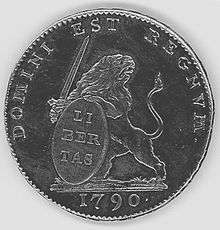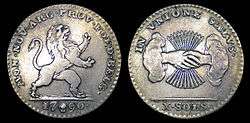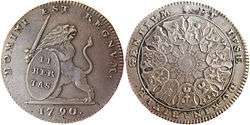Brabant Revolution coinage

The coinage of the United Belgian States was only produced during the state's one-year existence in 1790, following the Brabant Revolution, but provided a strong numismatic influence for the coinage of Belgium after its independence in 1830.
Background
In 1789, Brabant Revolution took place in reaction to liberal reforms made by Joseph II and the Austrian rule in Belgium. After Austrian forces were defeated by the rebels at the Battle of Turnhout in 1789, Austrian forces withdrew from the country leaving the rebels in power. On 11 January 1790, with the signing of the Treaty of Union, the counties and dukedoms which had made up the Austrian Netherlands became one country: the United Belgian States.
Coinage
The coinage was issued in eight denominations[1] divided into Liards, Sols, and Florins. It was only produced during the short one-year lifespan of the country meaning that all examples are dated 1790. Legends are rendered in Latin.
The types minted were:
| Denomination | Description | Legend | Metal | Photograph |
|---|---|---|---|---|
| Liard | Reverse: Rampant lion holding stylised liberty pole Obverse: Text |
Ad Usus Foederate Belgii "For Use in the Belgian Federation" |
Copper alloy | |
| Double Liard | Reverse: Rampant lion holding stylised liberty pole Obverse: Laureate wreath surrounding text |
Ad Usus Foederate Belgii | Copper alloy | |
| Ten Sols | Reverse: Two disembodied hands shaking above 11 crossed arrows Obverse: Rampant lion |
In Unione Salus "Salvation in Union" |
Silver |  |
| Florin | Reverse: Two disembodied hands shaking above 11 crossed arrows Obverse: Rampant lion |
In Unione Salus | Silver | |
| Three Florins | Reverse: Lion regardant, brandishing sword and a shield labelled Libertas Obverse: 11 coats of arms around a central son |
Domini est Regnum "Our Kingdom is the Lord's" |
Silver |  |
| Ten Florins | Reverse: Lion regardant, brandishing sword and a shield labelled Libertas Obverse: 11 coats of arms around a central son |
Domini est Regnum | Gold | |
| 14 Florins[2][3] | Reverse: Lion regardant, brandishing sword and a shield labelled Libertas Obverse: 11 coats of arms around a central son |
Domini est Regnum | Gold |
Iconography
The iconography on the coinage stressed the unity of the state. On the 3 Florin, this was represented by the individual display of all the coats-of-arms of the 11 states which had merged; on the 10 sols, it was represented by 11 arrows behind a two shaking hands.[4]
References
- ↑ "Republic of Belgium, Lion d'or 1790". Money Museum. Retrieved 20 February 2013.
- ↑ "Belgium 1790 lion d'or". Coin Wiki. Retrieved 20 February 2013.
- ↑ "Belgium. Lion d' Or of 14 Florins, 1790 (Brussels)". icollector.com. Retrieved 20 February 2013.
- ↑ "Belgium: 10 Sols 1790". CACHE' Historical and World Coins. Retrieved 19 February 2013.
Further reading
- Cumont, Georges (1882). "Les Monnaies des États-Belgiques-Unis [1]" (PDF). Revue Belge de Numismatique. 38: 627–33.
- Cumont, Georges (1883). "Les Monnaies des États-Belgiques-Unis [2]" (PDF). Revue Belge de Numismatique. 39: 323–32.
External links
- Révolution Brabançonne at iBelgica
- De Verenigde Belgische Staten at Numismatica-herentals
- The first "Belgian" coins: Lions d’or and lions d’argent of the United Belgian States at the National Bank of Belgium (NBB) Museum